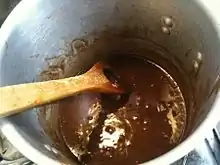Demi-glace
Demi-glace (English: "half glaze") is a rich brown sauce in French cuisine used by itself or as a base for other sauces. The term comes from the French word glace, which, when used in reference to a sauce, means "icing" or "glaze." It is traditionally made by combining one part Espagnole sauce and one part brown stock. The sauce is then reduced by half, strained of any left over impurities and finished with a sherry wine.[1]
 A pork chop with brussels sprouts, a sweet potato purée, and a mushroom demi-glace | |
| Type | Sauce |
|---|---|
| Place of origin | France |
| Main ingredients | beef or chicken stock |
| Variations | demi-glace au boeuf, demi-glace au poulet |
Common variants of demi-glace use a 1:1 mixture of beef or chicken stock to sauce espagnole; these are referred to as "beef demi-glace" (demi-glace au boeuf) or "chicken demi-glace" (demi-glace au poulet). The term "demi-glace" by itself implies that it is made with the traditional veal stock.
Preparation

The basic recipe for demi-glace is provided by the French chef Auguste Escoffier, who is often considered to have refined the method of French cooking, as well as codified many standard French recipes. Although many recipes for demi-glace give the preparation for the espagnole first, and then the recipe for the brown stock, preparation should actually proceed in the reverse.
A basic brown stock should be prepared, and when completed, left on the heat to remain very warm. At this point, the espagnole is prepared, and when it is finished, the brown stock is added in equal portions to the espagnole. Demi-glace keeps very well, about six months refrigerated or almost indefinitely frozen.
Due to the considerable effort involved in making the traditional demi-glace, chefs commonly substitute a simple jus lié of veal stock or to create a simulated version, which the American cookbook author Julia Child referred to as a "semi-demi-glace"(i.e. sans espagnole sauce).[2][3] However, even today, many chefs who prepare French haute cuisine use a demi-glace prepared in their own kitchen. Concentrates and mixes, mostly available to professional kitchens, are another way of avoiding the labor involved in preparing the sauce.
See also
References
- Escoffier, A. (Auguste); Escoffier, A. (Auguste); Herndon, James B.; Herndon/Vehling Collection. fmo (1907). A guide to modern cookery. Cornell University Library. London : W. Heinemann.
- William Black (31 October 2011). Plats du Jour. Transworld. p. 153. ISBN 978-1-4481-0939-5.
- Martha Stewart (20 December 2011). Martha Stewart's Cooking School: Lessons and Recipes for the Home Cook. Potter/TenSpeed/Harmony. p. 134. ISBN 978-0-307-95358-2.
Further reading
- Escoffier, Auguste (1907). A Guide to Modern Cookery. London: William Heinemann. p. 19. OCLC 5362680. OL 24167463M. Retrieved September 22, 2014. For Auguste Escoffier's half glaze recipe.
External links
- Emeril Lagasse's recipe for demi-glace on foodnetwork.com—largely follows Escoffier's original recipe